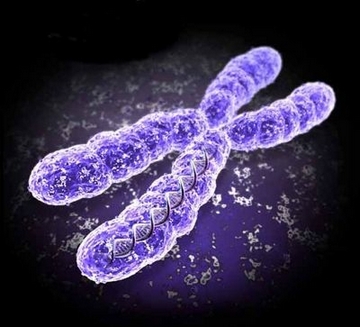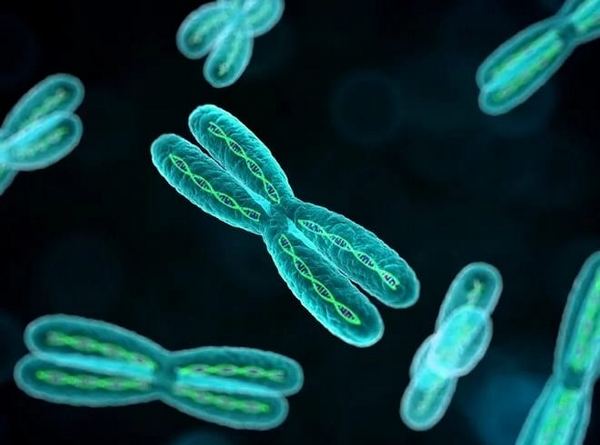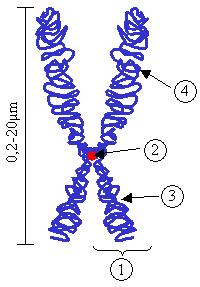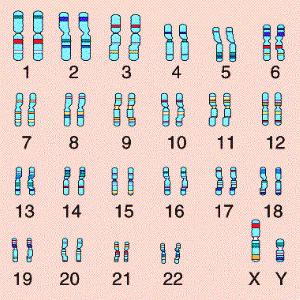Chromosomes

Content:
Definition
Chromosomes are nucleoprotein structures of a eukaryotic cell. Most of the genetic information is stored in chromosomes. Due to its ability to reproduce itself, it is the chromosomes that provide the genetic link between generations. Chromosomes are formed from a long DNA molecule, which contains a linear group of many genes, and all genetic information, whether it be about a human, an animal, a plant, or any other living creature.
The morphology of chromosomes is connected with the level of their spiralization. So, chromosomes are maximally expanded during the interphase stage. Then with the beginning of the cell division, the chromosomes actively spiralize and shorten. They reach their maximum shortening during the metaphase stage when new structures are formed. This phase is most convenient for studying the function of chromosomes, their morphological characteristics.
Discovery
Back in the middle of the XIX century, many biologists (who were studying the structure of plant and animal cells under a microscope) drew attention to the thin filaments and the smallest ring-shaped structures in the nucleus of some cells. The German scientist Walter Fleming used aniline dyes to process the nuclear structures of the cell. Doing this he discovered the chromosomes. More precisely, the detected substance was named by him “chromatid” for its ability to stain, and the term “chromosomes” was introduced into use a little later (in 1888) by another German scientist, Heinrich Wilder. The word “chromosome” comes from the Greek words “chroma” – coloring and “somo” – body.

Chromosomal Theory of Heredity
The history of the study of chromosomes did not end at their discovery. So in 1901-1902, the American scientists Wilson and Saton drew attention to the similarity in the behavior of chromosomes and Mendeleev’s factors of heredity – genes. Scientists came to the conclusion that genes are located on chromosomes. The genetic information is transmitted from parents to children, thanks to chromosomes.
Back in 1915-1920, the participation of chromosomes in gene transfer was proven in practice in a series of experiments made by the American scientist Morgan and his laboratory staff. They managed to localize several hundred hereditary genes in the chromosomes of the Drosophila fly and create a genetic map of chromosomes. The chromosomal theory of heredity was created based on these data.
Structure
What is the structure of a chromosome? The structure of chromosomes varies depending on the type, so the metaphase chromosome (formed in the metaphase stage during mitotic cell division) consists of two longitudinal strands – the chromatids, which connect at a place called the centromere. The centromere is a part of a chromosome that is responsible for the divergence of sister chromatids into daughter cells. It also divides the chromosome into two parts, called the short and long arm. It is also responsible for the division of the chromosome since it contains a special substance – kinetochore, to which the structures of the spindle are attached.

This picture shows the visual structure of the chromosome: 1. chromatids, 2. centromere, 3. short chromatid shoulder, 4. long chromatid shoulder. Telomeres are special elements that protect the chromosome from damage and prevent sticking of fragments; they are located at the ends of the chromatid.
Types
The sizes of the chromosomes of plants and animals vary considerably: from fractions of a micron to tens of microns. The average lengths of human metaphase chromosomes lie in the range from 1.5 to 10 microns. Depending on the type of chromosome, their staining abilities also differ. Depending on the location of the centromere, these forms of chromosomes are distinguished:
- Metacentric chromosomes, which are characterized by the middle location of the centromere.
- Submetacentric chromosomes, they are characterized by the uneven arrangement of chromatids, when one arm is longer and the second is shorter.
- Acrocentric or rod-shaped chromosomes have a centromere located almost at the very end of the chromosome.
Functions
The main functions of chromosomes (both for animals and for plants and in general for all living beings) are the transmission of hereditary, genetic information from parents to children.
Set of Chromosomes
The importance of chromosomes is so great that their number in the cells (as well as the characteristics of each chromosome) determine the characteristic feature of one or another biological species. For example, there are 8 chromosomes in the Drosophila fly. Monkeys have 48 chromosomes. How many chromosomes are in a human? Humans have 46 chromosomes.
There are two main types of chromosome sets in nature: single or haploid (contained in germ cells) and double or diploid. The diploid set of chromosomes has a paired structure, that is, the entire set of chromosomes consists of chromosomal pairs.
Human Set of Chromosomes
As we wrote above, the cells of the human body contain 46 chromosomes, which are combined into 23 pairs. Together they make up the chromosome set of a person. The first 22 pairs of human chromosomes (they are called autosomes) are common for both men and women, and only the last pair – gender chromosomes – differ in different genders, it also determines the gender of a person. The combination of all pairs of chromosomes is also called the karyotype.

This is the human set of chromosomes. It has 22 pairs of double diploid chromosomes contain all our hereditary information. The last pair is different, in men it consists of a pair of X and Y gender chromosomes, while women have two X chromosomes.
All animals have a similar structure of the chromosome set, only the number of non-gender chromosomes in each of them has its own.
Genetic Diseases
Violation of the chromosomes or even their wrong number is the cause of many genetic diseases. For example, Down syndrome occurs due to the presence of an extra chromosome in the human chromosome set. Genetic diseases as color blindness, hemophilia are caused by malfunctions of the existing chromosomes.
References and Further Reading
- Hammond CM, Stromme CB, Huang H, Patel DJ, Groth A (March 2017). “Histone chaperone networks shaping chromatin function”. Nature Reviews. Molecular Cell Biology. 18 (3): 141–158. doi:10.1038/nrm.2016.159. PMC 5319910. PMID 28053344.
- Wilson, John (2002). Molecular biology of the cell : a problems approach. New York: Garland Science. ISBN 978-0-8153-3577-1.
- Alberts B, Bray D, Hopkin K, Johnson A, Lewis J, Raff M, Roberts K, Walter P (2014). Essential Cell Biology (Fourth ed.). New York, NY, USA: Garland Science. pp. 621–626. ISBN 978-0-8153-4454-4.
- Jump up to: a b c Schleyden, M. J. (1847). Microscopical researches into the accordance in the structure and growth of animals and plants.
- Antonin W, Neumann H (June 2016). “Chromosome condensation and decondensation during mitosis”. Current Opinion in Cell Biology. 40: 15–22. doi:10.1016/j.ceb.2016.01.013. PMID 26895139.

Author: Pavlo Chaika, Editor-in-Chief of the journal Poznavayka
When writing this article, I tried to make it as interesting and useful as possible. I would be grateful for any feedback and constructive criticism in the form of comments to the article. You can also write your wish/question/suggestion to my mail pavelchaika1983@gmail.com or to Facebook.

